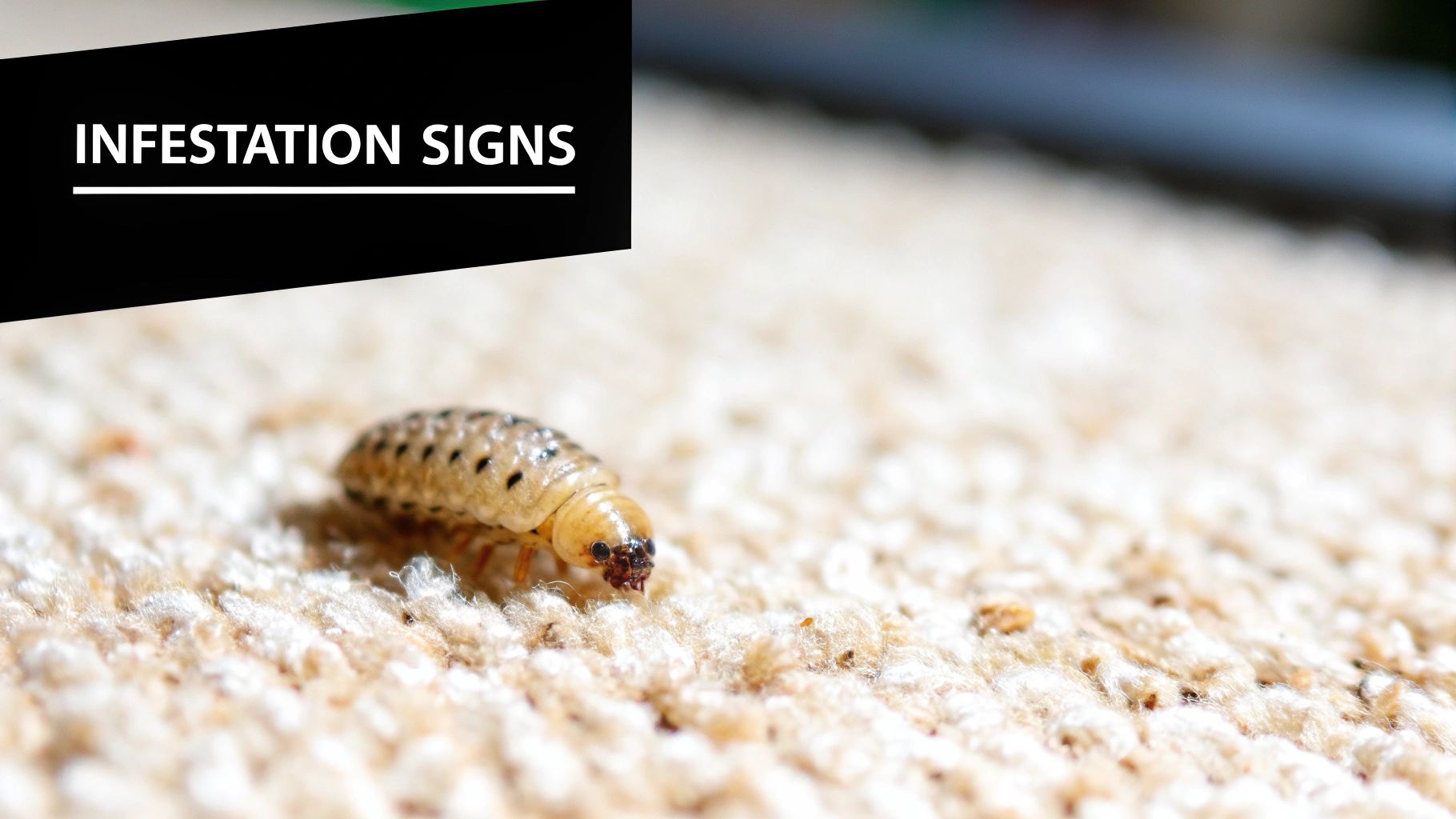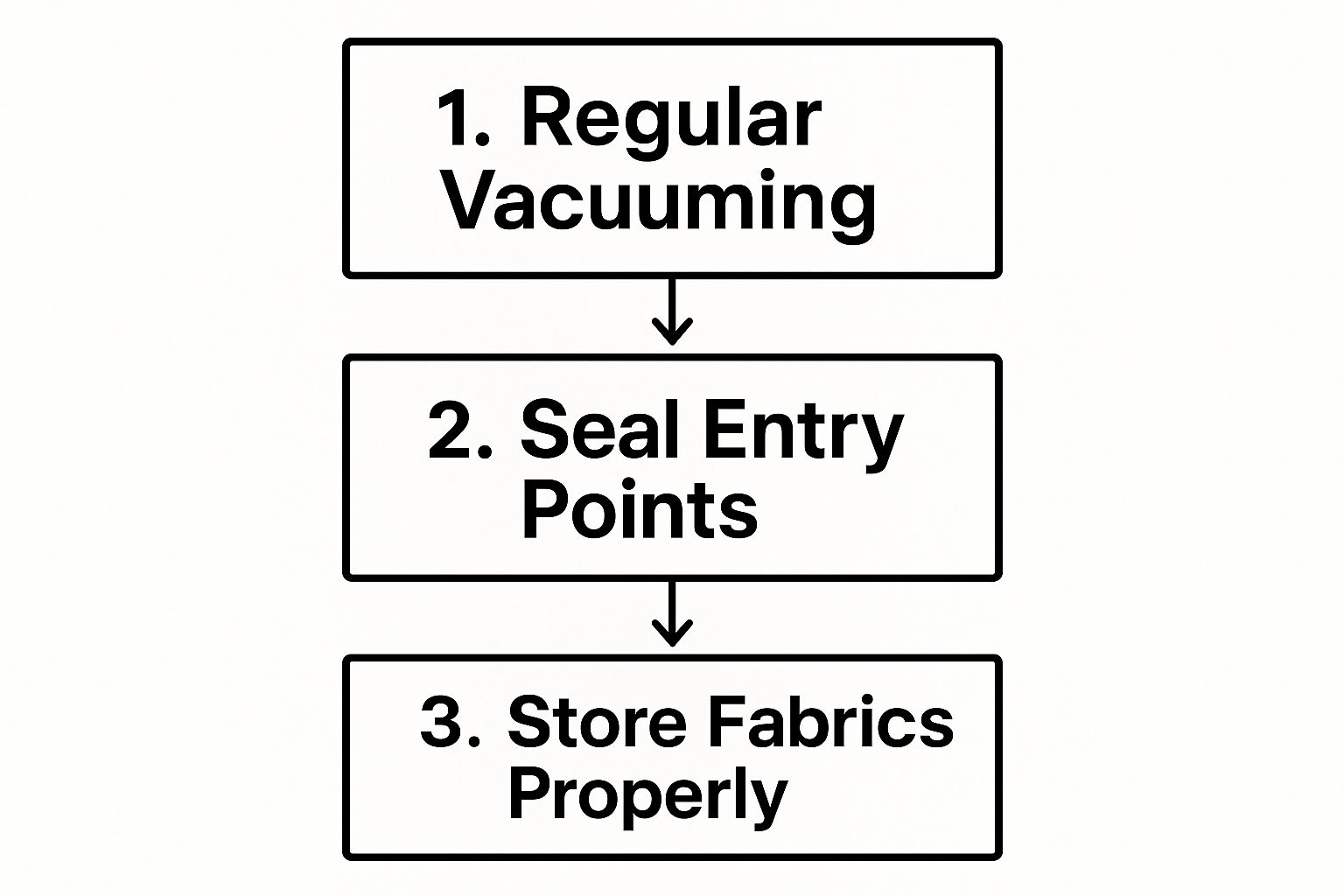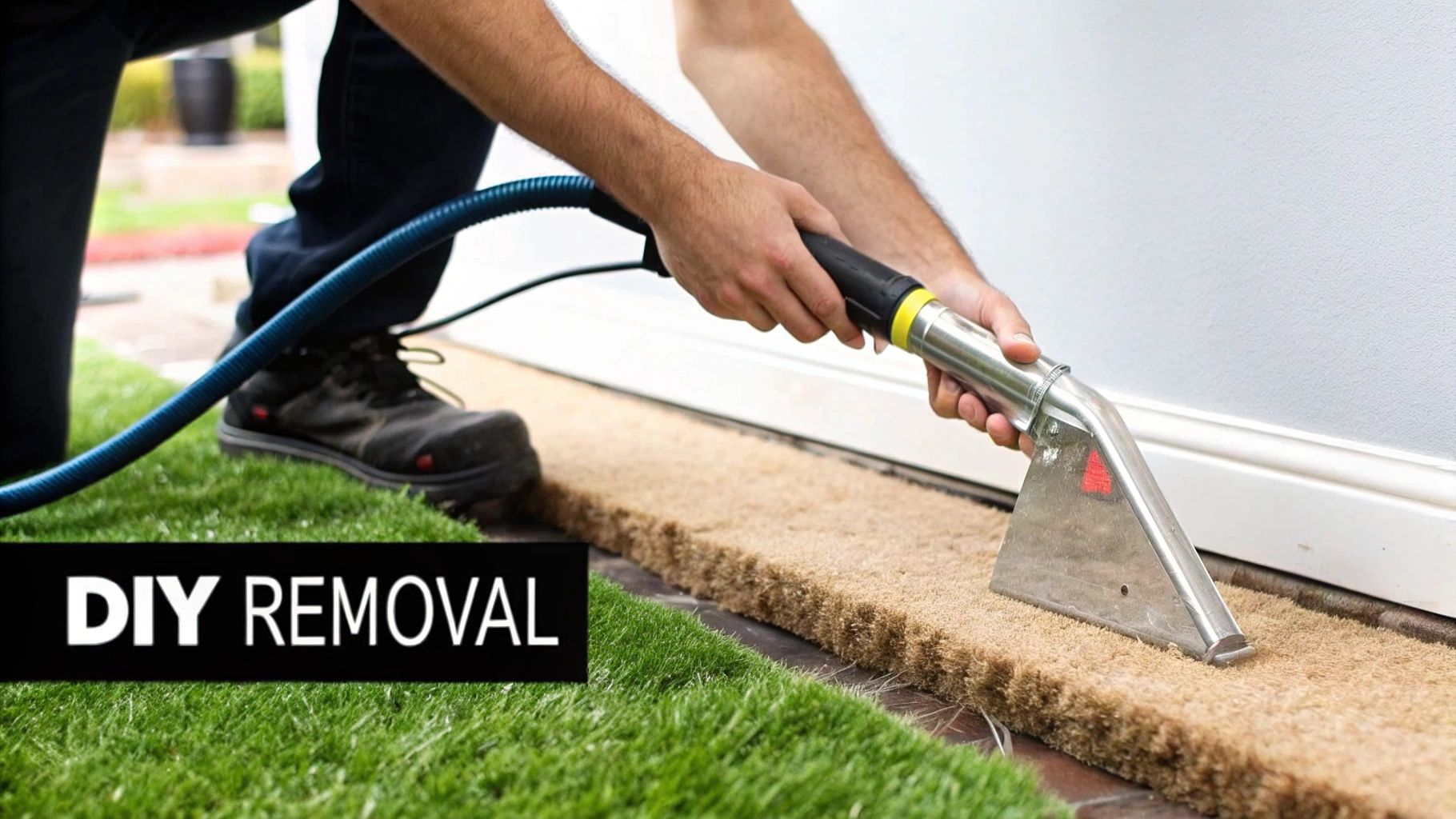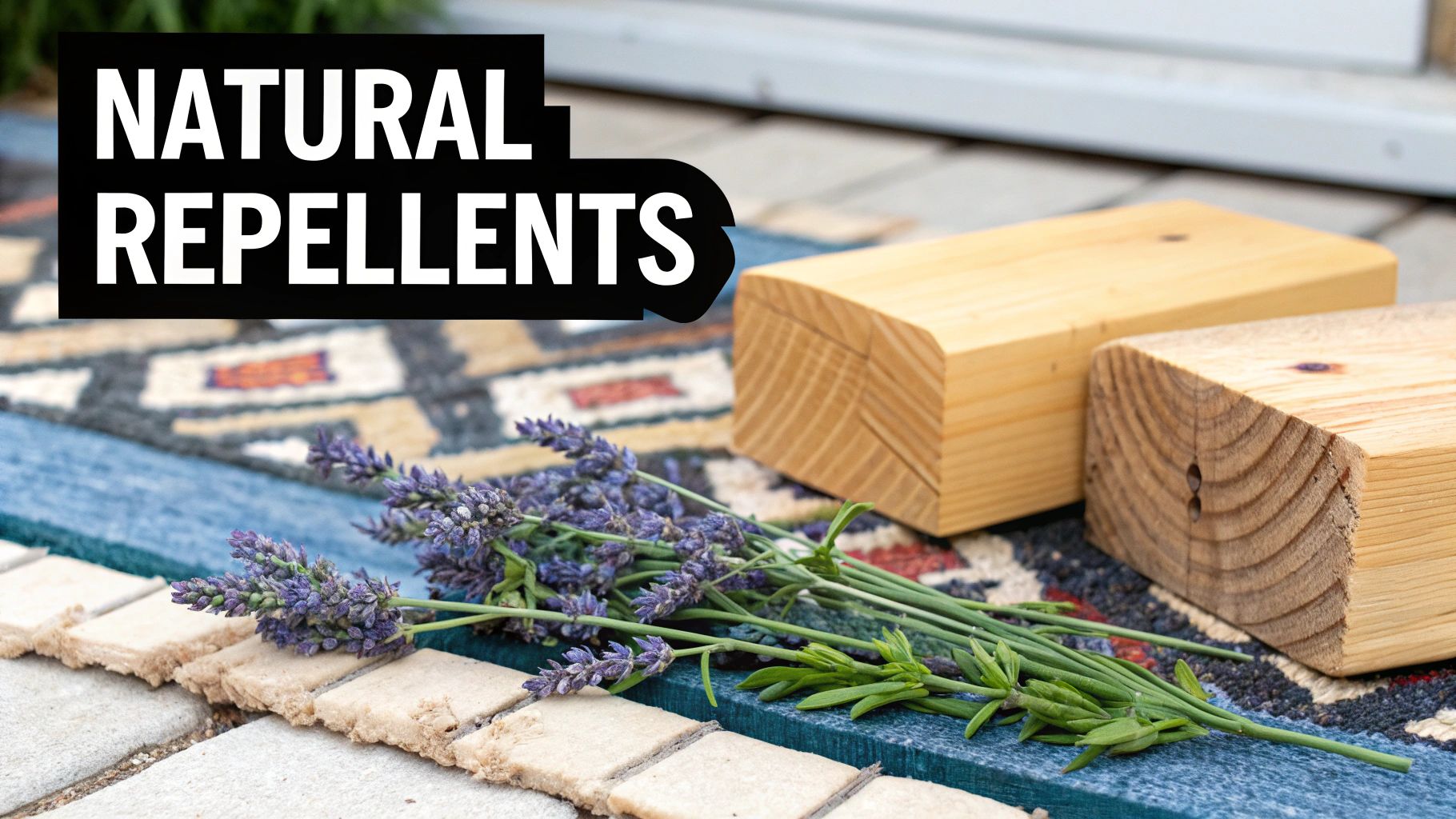To get rid of carpet beetles for good, you need a three-pronged attack: correct identification, a deep, thorough clean, and targeted treatments. Your absolute top priority has to be eliminating the larvae. These tiny, hairy grubs, often nicknamed 'woolly bears', are the real troublemakers, causing all the damage by munching on natural fibres like wool, silk, and leather.
A combination of vigorous vacuuming, steam cleaning, and treating the affected items is always your most effective strategy.
Spotting the Signs of Carpet Beetles

Before you start any treatment, you need to be 100% certain you’re dealing with carpet beetles. It’s easy to mistake them for other pests like clothes moths, and using the wrong approach is just a waste of time and effort. The real damage isn’t caused by the adult beetles you might spot crawling near windows, but by their hungry offspring.
The larvae are the true culprits, silently chewing their way through your prized possessions. In the UK, carpet beetles are a surprisingly common and often overlooked pest. The varied carpet beetle, a frequent home invader, is tiny, measuring just 2 to 5 mm long. But don't let their size fool you. A single female can lay between 40 to 100 eggs, which hatch in about two weeks and unleash larvae that can feed for months on end. You can read more about how carpet beetles thrive in UK homes to get a better handle on their lifecycle.
Distinguishing Adults from Larvae
Adult carpet beetles are small, oval-shaped insects. They have a distinctive mottled pattern of black, white, and brown on their backs. You'll often find them near windowsills because, like many insects, they're drawn to light. Spotting even one adult is a major red flag that eggs have likely been laid somewhere else in your house.
The larvae, however, are what you really need to be hunting for. Known as ‘woolly bears’, they are hairy, grub-like creatures, usually a reddish-brown colour and a bit longer than the adults. Finding these confirms you have an active, ongoing infestation on your hands.
The single most undeniable piece of evidence of carpet beetles isn't the damage itself, but finding shed larval skins. These fragile, bristle-covered casings are a dead giveaway that larvae are growing, thriving, and feeding nearby.
Common Hiding Spots and Damage Patterns
Carpet beetle larvae love dark, quiet, undisturbed places where they have a ready supply of natural fibres to eat. This means you need to focus your search on areas that don't see a lot of day-to-day traffic.
Here are some prime locations to start your inspection:
- Beneath Heavy Furniture: Get a torch and check under sofas, bookcases, and beds that are rarely moved.
- Inside Wardrobes and Drawers: Carefully inspect the seams and folds of wool jumpers, silk scarves, and leather items.
- Along Skirting Boards: Larvae often feed on wool-based carpets right at the edge of a room, hidden from view.
- In Attics and Lofts: Old birds' nests are a common breeding ground, as they provide a feast of feathers and nesting material.
The damage they leave behind is quite distinct. Unlike the more uniform, smaller holes you see from moths, carpet beetle damage often appears as larger, irregular bare patches on carpets or scattered, threadbare areas on clothing. You might suddenly notice a wool rug is worn thin in one specific spot under a chair – that’s a classic sign that larvae have been feasting there.
Carpet Beetle Infestation Signs at a Glance
Sometimes, it helps to have a quick checklist. Use this table as a handy reference to spot the tell-tale signs of a carpet beetle problem in your home.
| Sign of Infestation | What to Look For | Common Locations |
|---|---|---|
| Visible Adult Beetles | Small, oval, mottled insects (2-5 mm) crawling slowly. | Windowsills, light fittings, walls, and near flowers (pollen is a food source). |
| Visible Larvae | Hairy, grub-like creatures ('woolly bears'), reddish-brown and slightly segmented. | Under furniture, in carpet fibres, inside wardrobes, along skirting boards. |
| Shed Larval Skins | Brittle, hollow, bristle-covered casings that look like the larvae themselves. | In the same hidden, dark places as the larvae. The most definitive sign. |
| Damage to Fabrics | Irregular, bare patches on wool carpets; scattered holes in clothing and textiles. | Edges of rugs, collars of wool coats, stored blankets, taxidermy, leather book-bindings. |
| Faecal Pellets | Tiny, dry droppings the size of a grain of salt, often matching the colour of the fabric eaten. | Clustered in areas where larvae have been feeding. |
Remember, finding just one of these signs is enough to warrant a more thorough investigation. The sooner you identify the problem, the easier it will be to stop it in its tracks.
A Deep Cleaning Plan to Eradicate Carpet Beetles

Spotting the signs is one thing; getting rid of the infestation is another. Now comes the methodical work. A successful campaign against carpet beetles hinges on a deep, systematic clean that targets every single stage of their lifecycle, from invisible eggs to adult beetles.
This isn't just about a quick pass with the hoover. Your goal is to completely disrupt their habitat and remove their food sources so thoroughly that there's nowhere left for them to hide, feed, or breed. That means tackling wardrobes, drawers, carpets, and upholstery with a clear, organised strategy.
Emptying and Treating Infested Areas
Start where they're most likely to be hiding: wardrobes, chests of drawers, and airing cupboards. You have to empty these spaces completely to get a true sense of the problem and treat fabrics effectively. Don't just shift things around—take everything out.
Once you’ve emptied the space, sort all your textiles into piles based on how they can be cleaned. This step is critical. Different materials need different methods to properly kill the eggs and larvae.
- Hot Wash: Anything machine-washable, like cottons, linens, and most synthetics, should go on a 60°C or higher cycle. That temperature is lethal to carpet beetle eggs and larvae.
- Dry Cleaning: For your delicate natural fibres like wool, silk, or cashmere, professional dry cleaning is the safest and most effective route. Make sure you tell the cleaner about the pest issue so they can take appropriate measures.
- Freezing: For smaller, non-washable items—think decorative cushions or delicate vintage clothes—you can seal them in a plastic bag and freeze them. A standard home freezer set to -18°C for at least 72 hours will kill any life stage present.
Remember, the source of the infestation is often a single forgotten item. It could be an old woollen blanket in a storage chest, a felt hat at the back of a wardrobe, or even a craft box with feathers. Finding and eliminating this "ground zero" is the key to stopping them from coming straight back.
Harnessing Heat and Suction Power
With your fabrics being treated, it's time to turn your attention to the carpets, rugs, and furniture left behind. This is where you can really dismantle the rest of the infestation.
A powerful vacuum cleaner with a crevice tool is your best friend here. Methodically hoover every inch of the affected rooms. Pay special attention to the edges along skirting boards, underneath radiators, and deep within the seams of upholstered furniture where larvae love to hide. Afterwards, immediately empty the vacuum bag or canister into an outside bin to prevent them from crawling back out.
For an even deeper clean, a steam cleaner is an invaluable tool. The high-temperature steam penetrates deep into carpet fibres and upholstery, killing any remaining eggs and larvae on contact. Work in slow, overlapping strokes to ensure the heat is applied evenly across the entire surface. This one-two punch of suction and heat leaves very little chance for survival and is a cornerstone of how to get rid of carpet beetles for good.
Applying the Right Treatments Safely and Effectively

Right, you’ve done the hard work with a deep clean, and now it's time to deliver the final blow. Applying the right treatment is what finishes off any stubborn larvae or hidden eggs you might have missed. Whether you go for a natural solution or a chemical insecticide really comes down to how bad the infestation is, who’s in your household (pets and children), and what you’re comfortable with.
The good news is, there are several solid DIY options available here in the UK. From gentle but effective powders to fast-acting chemical sprays, the trick is knowing what to use and where to put it for maximum impact. A strategic application is what separates a temporary fix from a long-term solution.
Choosing Your Treatment Method
For anyone leaning towards a non-chemical route, diatomaceous earth is an excellent choice. This isn't a poison; it's a fine powder made from fossilised algae that physically shreds the waxy exoskeletons of insects, causing them to dry out and die. It's a slow-burn method, but it’s incredibly effective when left undisturbed in low-traffic spots.
On the other hand, sometimes you just need a quicker knockdown. Chemical insecticides containing active ingredients like cyfluthrin are formulated to kill carpet beetles on contact. These are perfect for getting deep into the cracks and crevices where the larvae love to hide.
You have to be thorough. It's a non-negotiable part of any treatment plan. Believe it or not, official UK pest control data now shows that carpet beetle complaints have overtaken those for clothes moths. They've become our number one textile pest, mostly because they're so good at hiding in overlooked spots like old bird's nests in the loft or forgotten rugs. That's why meticulous application is absolutely essential.
Safe and Strategic Application
Whichever product you choose, the first thing you must do is read the label and follow the instructions to the letter. Safety always comes first, especially if you have children or pets roaming around.
When you're ready to apply the treatment, zero in on the hidden areas where larvae are most likely to be living.
- Along Skirting Boards: Use a crevice tool or a puffer bottle to get a fine layer of powder or a direct spray right into that gap between the floor and the wall.
- Underneath Furniture: Don't neglect the carpet under heavy sofas, beds, and bookcases. These are prime, undisturbed breeding grounds.
- Inside Wardrobes and Drawers: Empty everything out first. Then, lightly treat the corners and seams. Make sure any spray is completely dry before you even think about putting your clothes back in.
- In Cracks and Crevices: Pay close attention to any little gaps in floorboards or around pipes and radiators. These are the hideouts you need to target.
When dealing with a carpet beetle problem, it's wise to understand the pros and cons of different DIY treatments. Here’s a quick comparison to help you choose the best approach for your home.
Comparing Carpet Beetle Treatment Options
| Treatment Type | How It Works | Best For | Safety Notes |
|---|---|---|---|
| Diatomaceous Earth | A fine, natural powder that physically damages insect exoskeletons, causing dehydration. | Low-traffic areas like behind furniture, in wall voids, and along skirting board edges. | Food-grade versions are non-toxic, but always wear a mask to avoid inhaling the fine dust during application. |
| Insecticidal Sprays | Contains active ingredients (e.g., pyrethroids) that kill pests on contact. | Quick knockdown in cracks, crevices, and areas with visible larvae activity. | Keep pets and children away from treated areas until completely dry. Ensure good ventilation during use. |
| Boric Acid | A powder that acts as a stomach poison for insects when ingested during grooming. | Treating carpeted areas, underneath furniture, and inside upholstered items. | Can be a mild irritant. Avoid use on surfaces where food is prepared. Keep away from pets that may lick it. |
| Pheromone Traps | Uses a synthetic lure to attract and trap adult male beetles. | Monitoring for the presence of adult beetles to gauge the scale of the infestation. | Completely non-toxic and safe for all areas of the home, but won't eliminate larvae. |
Choosing the right tool for the job is half the battle. While traps are great for monitoring, you'll need a killing agent like diatomaceous earth or an insecticide to deal with the destructive larval stage.
Knowing When to Call a Professional
A committed DIY effort can sort out most minor carpet beetle issues. But there are definitely times when bringing in the experts is the smartest call you can make. If the problem is widespread, keeps coming back no matter what you do, or has spread into tricky spots like wall voids, it's time for professional help.
Pest control technicians have access to treatments and equipment that simply aren't available to the public. For instance, professional heat treatment is a game-changer—a highly effective, chemical-free method that wipes out textile pests at every single life stage. Have a look at our guide on professional heat treatment for textile pests to understand how it works.
Ultimately, an expert can provide a definitive solution and the peace of mind that comes with knowing the problem is gone for good.
Long-Term Prevention to Keep Them from Returning
Getting rid of an active infestation is a huge win, but the job isn't done yet. The real challenge is making sure those persistent pests don’t stage a comeback. Long-term prevention isn’t a single action; it’s about building a sustainable defence that makes your home permanently unwelcoming to carpet beetles.
This means cutting off their food supply, blocking entry routes, and disrupting their lifecycle before it can even get started. Think of it as shifting from a reactive battle to a proactive strategy. The goal is to remove the very conditions that let them thrive in the first place, turning your home from an inviting habitat into a fortress they can't breach.
Storing Your Valuables Securely
One of the most effective preventative steps is to rethink how you store anything made of natural fibres. Carpet beetle larvae crave wool, silk, feathers, and leather, so any off-season items packed away are prime targets. Cardboard boxes and loose bags just won't cut it.
Instead, invest in airtight solutions. To stop carpet beetles from returning and infesting stored fabrics, effective storage is crucial. For instance, you can read more on how to keep pests out of storage boxes for some really useful tips.
- Vacuum-sealed bags: These are perfect for bulky jumpers and blankets. They suck out all the air, leaving no room for pests to get in or survive.
- Hard plastic containers with locking lids: Ideal for everything from wool suits to silk scarves, these create an impenetrable barrier that larvae simply can’t chew through.
Before you store anything, make sure it is spotlessly clean. Even tiny traces of sweat or food stains can attract beetles, giving them an incentive to try and find a way inside.
Disrupting Their Lifecycle with Routine Cleaning
Consistent cleaning is your most powerful weapon. Adult beetles lay their eggs in undisturbed, lint-filled corners, so regular vacuuming removes both the eggs and the larvae’s food source. Don't just clean the visible areas; get into the spots they love most.
This means pulling out furniture to vacuum underneath, using a crevice tool along all skirting boards, and regularly cleaning inside wardrobes and drawers. A proper deep clean every season can make a massive difference.
The lifecycle of the varied carpet beetle lasts several months, with adults often entering homes between April and June. Larvae are most active in October, feeding intensely before winter. This is a critical period for vigilance, as larvae can migrate from places like old birds' nests in the loft into wardrobes and airing cupboards.
Sealing Entry Points and Removing Outdoor Sources
Carpet beetles don't just magically appear; they come from outside. Adult beetles are drawn to light and can fly in through open windows or tiny gaps in your home's structure. Take a walk around your property and look for potential weak points.
Seal cracks around window frames, check that vent covers are intact, and repair any damaged fly screens. It's also vital to remove outdoor breeding grounds near your home, such as old birds' or wasps' nests in eaves or attics. These are often the original source of an infestation.
This proactive approach is a key part of what we call Integrated Pest Management (IPM), a strategy focused on long-term prevention over quick fixes. You can learn more about this by checking out our guide on what Integrated Pest Management is. By making these simple, structural adjustments, you create a powerful, lasting barrier against future invasions.
When You Should Call a Pest Control Professional

While a determined DIY approach can certainly get on top of many carpet beetle problems, there are times when calling in a professional is not just an option—it's a necessity. Knowing when to escalate is key to saving your time, money, and sanity.
If you’ve followed every cleaning and treatment step meticulously but are still finding fresh signs of damage, it’s a clear signal the infestation is more deeply rooted than you can manage alone.
Recurring problems are another major red flag. If you successfully clear an infestation only for it to return a few months later, there's likely a hidden source you can't reach. Larvae can thrive in wall voids, under floorboards, or within loft insulation, making them impossible to eliminate with standard vacuuming and sprays. Professionals have the tools and expertise to pinpoint and treat these inaccessible hideouts.
Recognising a Severe Infestation
A severe or widespread infestation requires a level of intervention that goes beyond what’s available to the public. If you're finding larvae in multiple rooms, across different floors, or in high-value items that are difficult to treat, it's time to bring in an expert.
Consider calling for professional help if you notice:
- Widespread Damage: Finding signs of activity throughout the house rather than in one localised spot.
- Infestation in Structural Areas: Evidence of pests in lofts, wall cavities, or sub-floor spaces.
- Failure of DIY Methods: You have tried multiple treatments over several weeks with no lasting success.
Professionals have access to advanced treatments like controlled heat applications, which raise the temperature of a room to a level that is lethal to all life stages of carpet beetles, from eggs to adults. This method is incredibly effective and penetrates areas that sprays cannot reach.
When you hire a reputable service, you're not just paying for insecticides; you're investing in a professional assessment. A trained technician can identify the exact species, locate the primary source, and create a targeted strategy. For a comprehensive overview of what to expect, you can learn more about our professional pest control services and how we tackle stubborn infestations.
Making that call provides peace of mind and ensures the problem is solved completely.
Your Carpet Beetle Questions Answered
Even with the best plan, you’re bound to have questions when you're knee-deep in a pest control battle. Getting clear answers can give you the confidence to see the job through and finally get your home back. Here are some of the most common queries we tackle for UK homeowners.
Knowing your enemy is half the battle. Many people are surprised to learn how these pests even get inside, which can lead to a lot of confusion about where to focus their efforts.
Can Carpet Beetles Fly Into My Home?
Yes, they absolutely can. Adult carpet beetles are surprisingly good flyers and are drawn to daylight like moths to a flame. They usually find their way inside during the spring and early summer through open windows, doors left ajar, or tiny gaps around frames and vents.
Once they're in, they don't hang around in the open. Their one mission is to find a dark, undisturbed spot near a food source to lay their eggs. Think quiet wardrobes, the space behind a sofa, or a dusty corner in the loft. This is exactly why well-fitted window screens and sealing any obvious cracks are such crucial parts of keeping them out for good.
How Long Does It Take to Completely Get Rid of Them?
This is the big question, and the timeline really depends on how bad the infestation is. If you've caught a small, localised problem early, you might sort it within a few weeks with one very thorough clean-and-treat cycle.
However, a more established, widespread infestation requires real persistence. The full carpet beetle lifecycle, from egg to adult, can take several months. This means you have to stay vigilant. We always advise clients to continue their routine of deep vacuuming and monitoring for at least a year after the initial treatment. This ensures you catch any newly hatched larvae before they can start the cycle all over again.
A common mistake is relaxing your efforts too soon. Just because you haven’t seen an adult beetle for a month doesn’t mean the problem is solved. The unseen larvae could still be developing, ready to emerge and undo all your hard work.
Do I Really Need to Hire a Professional?
For a minor issue confined to a single rug or one wardrobe, a dedicated DIY approach can definitely work. If you have the time and are methodical about it, you can succeed on your own.
That said, we strongly advise calling in a professional for severe, widespread, or recurring infestations. If the beetles keep coming back, it’s a sure sign there’s a hidden source you’re missing. Experts have the experience to find these breeding sites in tricky places like wall cavities or under floorboards. We also have access to more powerful, specialised treatments that offer a complete and lasting solution.
Are Carpet Beetles Biting Me?
This is a frequent and very understandable concern, but the short answer is no. Carpet beetles do not bite people or pets. They have no interest in blood and feed only on natural fibres like wool, silk, and leather.
So what's causing the irritation? The larvae. They're covered in tiny, stiff, bristle-like hairs. For some people, direct contact with these hairs or the shed skins they leave behind can trigger an allergic reaction. This often results in an itchy, red rash that looks a lot like insect bites, a condition sometimes called "carpet beetle dermatitis." If you're experiencing skin irritation, it's almost certainly a reaction, not a bite.
If a persistent carpet beetle problem is causing you stress, don't hesitate to seek expert help. Pest Predators Limited offers professional, evidence-based solutions to eliminate infestations at their source and provide you with lasting peace of mind. Contact us today for a consultation.



